
Catalog excerpts
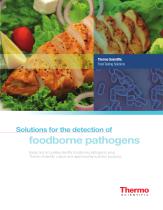
Thermo Scientific Food Testing Solutions foodborne pathogens Easily and accurately identify foodborne pathogens using Thermo Scientic culture and rapid biochemical test products.
Open the catalog to page 1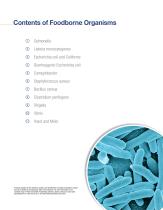
Contents of Foodborne Organisms © Escherichia coli and Coliforms © Diarrheagenic Escherichia coli Products available for the detection, isolation and identification of foodborne pathogens include but are not limited to the organisms listed in this reference. For more information on our complete range of Thermo Scientific microbiology solutions, please contact your local sales representative at 1-800-255-6730, or visit www.thermoscientific.com/remel.
Open the catalog to page 2
thermo Scientic Food Testing Solutions The Thermo Scientific microbiology portfolio includes an extensive range of products for the isolation, identification and enumeration of foodborne pathogens. These products range from culture media and diagnostic kits to quality control organisms. Our focus on providing quality products, on-time delivery and superior support is matched by our commitment to provide complete solutions that meet your testing needs. The Thermo Scientific Food Testing Solutions guide illustrates how our Oxoid and Remel brand microbiology products fit into the workow of a...
Open the catalog to page 3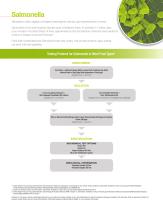
Salmonella Salmonella is a Gram-negative, rod-shaped, motile bacterium that can cause diarrheal illness in humans.1 Salmonellosis is the most frequently reported cause of foodborne illness. An estimated 1.2 million cases occur annually in the United States; of these, approximately 42,000 are laboratory-confirmed cases reported to Centers for Disease Control and Prevention.2 Foods often contaminated with Salmonella include meat, poultry, milk and dairy products, eggs, seafood, and some fruits and vegetables. Testing Protocol for Salmonella in Most Food Types3 enriChment Test Portion +...
Open the catalog to page 4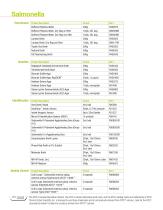
Salmonella Enrichment Buffered Peptone Water Buffered Peptone Water, Dry-Bag w/ filter Buffered Peptone Water, Dry-Bag w/o filter Lactose Broth Lactose Broth, Dry-Bag w/o filter Nutrient Broth Product Description Rappaport-Vassiladis Enrichment Broth Tetrathionate Broth Base Bismuth Sulfite Agar Bismuth Sulfite Agar, RapiDCM Hektoen Enteric Agar Hektoen Enteric Agar Xylose Lysine Desoxycholate (XLD) Agar Xylose Lysine Desoxycholate (XLD) Agar Product Description Urea Broth, Rapid BactiDrop Indole, Kovacs Indole Reagent, Kovacs Micro-ID Identification System (AOAC) Salmonella O Polyvalent...
Open the catalog to page 5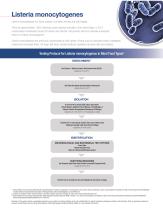
Listeria monocytogenes Listeria monocytogenes is a Gram-positive, non-spore forming rod with agella.1 There are approximately 1,600 Listeriosis cases reported annually in the United States. In 2011, contaminated cantaloupes caused 30 deaths and infected 146 persons with four outbreak-associated strains of Listeria monocytogenes.2 Listeria monocytogenes has previously contaminated a wide variety of foods such as uncooked meats, vegetables, cooked and processed foods, hot dogs, deli meat, smoked seafood, unpasteurized (raw) milk and cheeses. Testing Protocol for Listeria monocytogenes in Most...
Open the catalog to page 6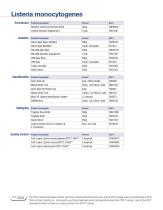
Listeria monocytogenes Enrichment Product Description Oxford Agar, Modified PALCAM Agar Base PALCAM Selective Supplement Yeast Extract Product Description Gram Stain Kit Plastic Tray Micro-ID Listeria Identification System Product Description Tryptone Soya Broth Tryptose Broth Yeast Extract Listeria Antisera Set (8 O-antisera & 4 H-antisera) Culti-Loops Listeria monocytogenes ATCC 7644 Culti-Loops Listeria innocua ATCC 33090 Culti-Loops Listeria grayi ATCC® 25401™† Quality Control Oxford Agar Base, Modified Listeria Selective Supplement Buffered Listeria Enrichment Broth Product Description...
Open the catalog to page 7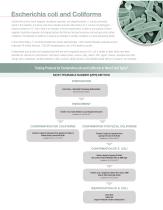
escherichia coli and Coliforms Escherichia coli are Gram-negative, facultative anaerobe, rod-shaped bacteria. E. coli are commonly found in the intestine of humans and warm-blooded animals. Most strains of E. coli are not pathogenic; however presence of E. coli in food is an indicator of fecal contamination. Coliforms are a group of Gramnegative, facultative anaerobic rod-shaped bacteria that ferment lactose to produce acid and gas under certain conditions. The detection of coliforms is used as an indicator of sanitary conditions in a food-processing facility. In the United States, E. coli...
Open the catalog to page 8
Escherichia coli and Coliforms Testing Protocol for Escherichia coli and Coliforms in Most Food Types2 Solid Medium Method - Coliforms Preparation Test Portion + Butterfield’s Phosphate-Buffered Water Blend and prepare dilutions ISOLATION Transfer 2mL of each dilution into a petri dish and follow one of the two pour plate methods using Violet Red Bile Agar (VRBA) and/or Tryptic Soy Agar Incubate for 18 – 24 hr at 35°C Confirmation Pick 10 representative colonies and transfer to Brilliant Green Lactose Bile Broth Incubate for 24 – 48 hr at 35°C Identification Gram Strain LST-MUG Method for...
Open the catalog to page 9
Escherichia coli and Coliforms Preparation Phosphate Buffer, Butterfield’s, 90mL Phosphate Buffer, Butterfield’s, 99mL Phosphate Buffer, Butterfield’s, 225mL Product Description Lauryl Tryptose Broth Product Description Lauryl Tryptose Broth - RapiDCM Lauryl Tryptose Broth Violet Red Bile Agar, 200mL Violet Red Bile Agar Violet Red Bile Agar - RapiDCM Product Description Brilliant Green Bile Broth (w/Lactose), 2% Brilliant Green Bile Broth (w/Lactose), 2% Brilliant Green Bile Broth, 2% Lauryl Tryptose Broth Plate Count Agar Plate Count Agar (Standard Method Agar) Product Description Gram...
Open the catalog to page 10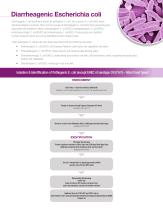
diarrheagenic escherichia coli Diarrheagenic E. coli (commonly known as pathogenic E. coli ), are a group of E. coli which cause diarrheal disease in humans. There are four groups of diarrheagenic E. coli which have previously been associated with foodborne illness; enterotoxigenic E. coli (ETEC), enteropathogenic E. coli (EPEC), enterohemorrhagic E. coli (EHEC) and enteroinvasive E. coli (EIEC). These groups are classified by their virulence factors and can be identified by their virulence traits. These pathogenic E. coli groups have been associated with the following food types: •...
Open the catalog to page 11All Thermo Scientific catalogs and technical brochures
-
CryoStar NX50
2 Pages
-
MSC-Advantage BSC
54 Pages
-
Multifuge
58 Pages
-
Thermo Scientific Pico 17 / 21
52 Pages
-
CO2 Incubator HERAcell 150 i / 240 i
196 Pages
-
Revco® Blood Bank Refrigerators
37 Pages
-
Multidrop Combi nL
4 Pages
-
Forma Environmental Chambers
25 Pages
-
MaxQ 6000
40 Pages
-
Multi Tube Rotator
13 Pages
-
picoSpin Spectrometer
6 Pages
-
1300 Series A2
76 Pages
-
CO2 Incubator Family
28 Pages
-
CO2 incubators
7 Pages
-
MaxQ Mini 4450 Shaker
40 Pages
-
E1-ClipTip Electronic Pipette
108 Pages
-
Varioskan™ LUX
54 Pages
-
ISQ Series Mass Spectrometers
412 Pages
-
Q Exactive™ BioPharma
16 Pages
-
Q Exactive Plus
4 Pages
-
LTQ XL™
4 Pages
-
Platinum DNA polymerases
6 Pages
-
-80°C Benchtop Freezer
2 Pages
-
Nicolet iS10 FT-IR Spectrometer
12 Pages
-
Ion S5 and Ion S5 XL Systems
2 Pages
-
SureTect Range
4 Pages
-
QuantStudio™ 3
8 Pages
-
Furnaces
2 Pages
-
Nunc Serological Pipettes
3 Pages
-
Nunc Cell Factory systems
8 Pages
-
Vanquish Duo UHPLC System [ZH]
12 Pages
-
native MS
16 Pages
-
Compound Discoverer Software
12 Pages
-
Vanquish Horizon UHPLC System
16 Pages
-
Thermo Scientific TSQ Duo
9 Pages
-
Thermo Scientific TSQ 8000 Evo
16 Pages
-
Heraeus Labofuge 300
2 Pages
-
Heraeus Cryofuge 5500i
8 Pages
-
Heraeus Clinifuge Centrifuge
2 Pages
-
Vials and Closures Catalog 2014-2015
128 Pages
-
RM 200 EG
4 Pages
-
Darwin LIMS
2 Pages
-
Immunohistory Solutions
292 Pages
-
Process Water Products Catalog
68 Pages
-
Technical Training Catalog
15 Pages
-
FBS Alternatives
8 Pages
-
Pierce Magnetic Beads
16 Pages
-
interactive catalog today
222 Pages
-
HERAGUARD HPH clean benches
2 Pages
-
MBC 240 Bench Top Analyzer
4 Pages
-
Konelab 20
2 Pages
-
Indiko
6 Pages



























































































![ISQ 7000 Single Quadrupole GC-MS System VPI [ZH]](https://img.medicalexpo.com/pdf/repository_me/78678/isq-7000-single-quadrupole-gc-ms-system-vpi-zh-191148_1mg.jpg)
![ISQ 7000 Single Quadrupole GC-MS System [ZH]](https://img.medicalexpo.com/pdf/repository_me/78678/isq-7000-single-quadrupole-gc-ms-system-zh-191147_1mg.jpg)
![Vanquish Duo UHPLC System [ZH]](https://img.medicalexpo.com/pdf/repository_me/78678/vanquish-duo-uhplc-system-zh-191145_1mg.jpg)





















































![Thermo Scientific Herasafe KS and KSP Class II Biological Safety Cabinets [EN]](https://img.medicalexpo.com/pdf/repository_me/78678/thermo-scientific-herasafe-ks-ksp-class-ii-biological-safety-cabinets-en-85081_1mg.jpg)











